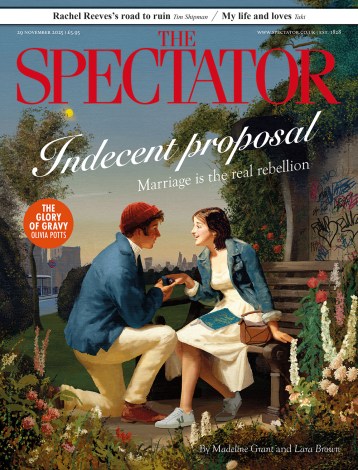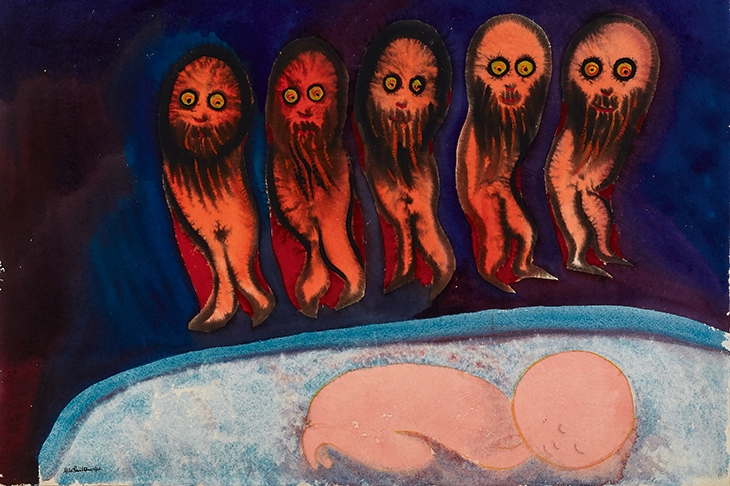Holding the International Surrealist Exhibition in London in 1936 was a coup for the British avant-garde, putting newbie surrealists such as Paul Nash and Roland Penrose on an equal footing with founding members of the European movement. But André Breton, who opened the show, was unimpressed by Nash, Penrose and co. Instead, he singled out two complete unknowns, Grace Pailthorpe and Reuben Mednikoff, as ‘the best and most truly surrealist’ of the British contingent.
Pailthorpe and Mednikoff came out of nowhere. He was the artist son of a Russian-Jewish tinplate maker from the East End; she was the daughter of a Sussex stockbroker and had served as a surgeon during the first world war before training as a psychoanalyst. They hooked up at a party just a year before the 1936 exhibition, when he was 29 and she was 51. She had thought he might help to open the mind of one of her patients through art therapy, but soon decided he might help cure her writer’s block. It was a coup de foudre psychologique.
Pailthorpe was a fast worker. Within a couple of months she had found a cottage in Cornwall where they could conduct research into the liberating effects of automatic drawing. She trained Mednikoff in the analytic method; he overcame her fears about handling paints. Together they developed a process they called ‘psychorealism’, which they promoted as a shortcut to the unconscious, avoiding the longueurs of Freud’s royal road of dreams. The unconscious, Pailthorpe said, ‘tells a perfect short story’. On the evidence of Camden Arts Centre’s current exhibition, it also paints some remarkable pictures.
Step inside this show and you realise Breton was right. There’s a vibrancy and exuberance about the paintings that blows away the stale air of self-consciousness hanging around so much British surrealism. ‘Sixty-five of the goofiest paintings London has ever seen,’ was the verdict of one reviewer on the couple’s joint exhibition at Guggenheim Jeune in 1939. London has seen plenty of goofy paintings since, but in an increasingly crowded field theirs still stand out.
Given the references to Oedipal feelings, sibling rivalries and toilet-training traumas, the goofiness tends towards the scatological, though without the artists’ interpretations you might not guess it. Pailthorpe’s ‘Standbumptious’ (1937), for instance, depicts ‘a magnificent penis… pizzing in the female manner’ in a sprightly style combining the graphic tension of Gerald Scarfe with the loopy energy of Dr Seuss. Several pictures would make marvellous children’s illustrations: the monstrous tiger in Mednikoff’s ‘The Bengal Colonel’ (1945–7) is a progenitor of Maurice Sendak’s Wild Things, with sharper claws and teeth.
Mednikoff’s art training gave his work a professionalism that belies its automatism; Pailthorpe’s images are wilder, more outsider-arty. Some are really quite disturbing: ‘The Five Firemen’ (1938), with its row of glowing jellyfish-like incubi hovering ghoul-eyed above a baby’s cot, is the stuff of nightmares. But there’s nothing nightmarish about the radiant, free-flowing abstract watercolours she produced in 1970, the year before her death aged 87; reminiscent of psychedelic liquid light shows, they’re pure outpourings of pleasure in movement and colour.
Pailthorpe started out with high hopes for psychorealism, believing it might help to cure the ‘virus of hate’ infecting interwar Europe; in her 1941 essay ‘The Cradle and Politics’ she blamed the political violence on Hitler’s and Mussolini’s inability to share the nursery as babies. Her mission was to save the world through doodling. After Hiroshima, Mednikoff decided the world was past saving: ‘Atomic bombs made the whole idea of helping humanity a fiasco,’ he wrote in 1951. But the idea of dictators as angry babies still flies. Bring on the Trump-baby blimp.
A Tale of Mother’s Bones: Grace Pailthorpe, Reuben Mednikoff and the Birth of Psychorealism
Where: Camden Arts Centre
Date: until 23 June






Comments